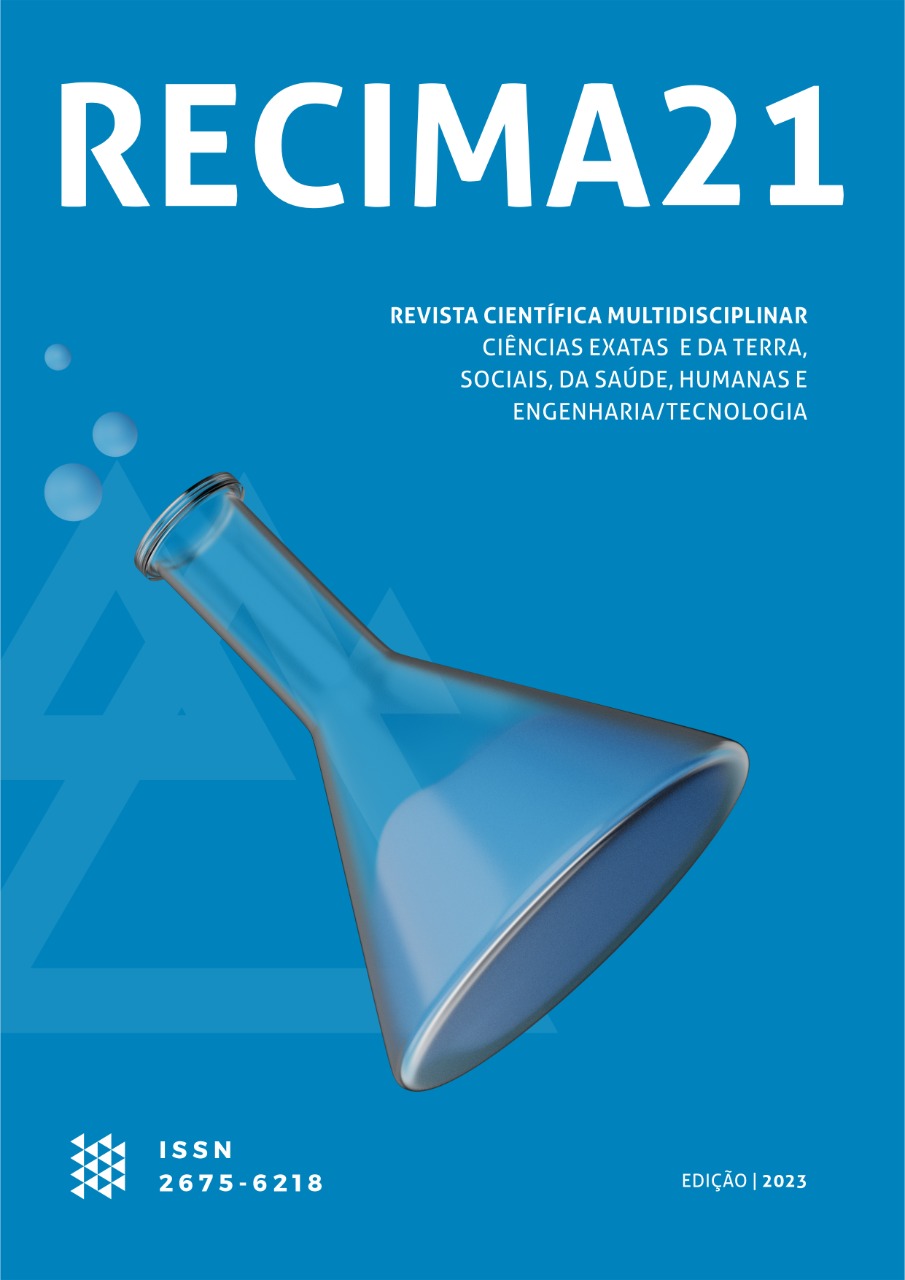ANÁLISIS DE LA VIABILIDAD DE LA REANIMACIÓN CARDIOPULMONAR DURANTE EL VUELO EN LAS AERONAVES DEL BATALLÓN POLICIAL MILITAR DE OPERACIONES AÉREAS DE PARANÁ.
DOI:
https://doi.org/10.47820/recima21.v4i7.3488Palabras clave:
Reanimación cardiopulmonar, Helicóptero, Compresión torácica, DesfibriladorResumen
Este artículo tiene como objetivo discutir la viabilidad y las opciones de técnicas adecuadas de reanimación cardiopulmonar (RCP) para ser utilizadas en vuelo en las aeronaves de alas rotatorias del Batallón Policial Militar de Operaciones Aéreas de Paraná (BPMOA). La rapidez en la atención prehospitalaria influye significativamente en la supervivencia de una víctima. Es importante que los equipos médicos estén preparados para realizar intervenciones de emergencia en cualquier entorno, incluyendo las aeronaves. La investigación realizada para respaldar el artículo abarcó la búsqueda de artículos científicos en medios especializados. El BPMOA utiliza tres helicópteros del modelo EC 130 B4 para el servicio aeromédico. La realización de RCP en un helicóptero presenta algunas dificultades, como la limitación de espacio, la inestabilidad del entorno y la interferencia de ruidos y vibraciones. Estudios han demostrado los resultados efectivos de las compresiones torácicas en helicópteros, utilizando maniquíes, demostrando que la calidad de las compresiones torácicas puede verse afectada por factores como la posición del paciente, la altura del socorrista y la frecuencia de las compresiones. Al describir el uso de la mCPR durante el transporte en helicóptero, los dispositivos mecánicos de compresión torácica pueden proporcionar RCP de alta calidad de manera segura y durante períodos prolongados de transporte. La implementación rápida de la desfibrilación, incluido el uso inmediato de desfibriladores externos automáticos (DEA) por parte de profesionales de emergencias y personas con capacitación adecuada, ha resultado en un aumento significativo en las tasas de supervivencia en casos de paro cardíaco fuera del entorno hospitalario.
Descargas
Citas
ABELAIRAS-GÓMEZ, C. et al. Cardiopulmonary resuscitation quality by helicopter rescue swimmers while flying. Air Med J, v. 35, p. 288-291, 2016.
ADGEY, A. A. et al. Management of ventricular fibrillation out of Hospital. Lancet, v. 1, p. 1169-1171, 1969.
ALBARRAN-SOTELO, R. et al. Healthcare provider’s manual for Basic Cardiac Life Support. Dallas, TX: American Heart Association, 1988, pp. 40-43.
AMERICAN HEART ASSOCIATION (AHA). Guidelines CPR. Destaques das diretrizes da American Heart Association 2020 para RCP e ACE. Dallas: American Heart Association, 2020. Disponível em: <https://cpr.heart.org/-/media/CPR-Files/CPR-Guidelines-Files/Highlights/Hghlghts_2020ECCGuidelines_Portuguese.pdf>. Acesso em: 23 maio 2023.
AMERICAN HEART ASSOCIATION in collaboration with THE INTERNATIONAL LIAISON COMMITTEE ON RESUSCITATION. Guidelines 2000 for Cardiopulmonary Resuscitation and Emergency Cardiovascular Care. Part 6: Advanced Cardiovascular Life Support. Circulation, v. 102, p. I86-I172, 2000.
BARCALA-FURELOS, R. et al. Influence of automatic compression device and water rescue equipment in quality lifesaving and cardiopulmonary resuscitation. Hong Kong J Emerg Med, v. 21, p. 391-399, 2014.
BAXT, W. G.; MOODY, P. The impact of a physician as part of the aeromedical prehospital team in patients with blunt trauma. JAMA, v. 257, p. 3246, 1987.
BAXT, W. G.; MOODY, P. The impact of a rotorcraft aeromedical emergency care service on trauma mortality. JAMA, v. 249, n. 22, p. 3047, 1983.
BLACKWELL, T. H.; KAUFMAN, J. S. Response time effectiveness: comparison of response time and survival in an urban emergency medical services system. Acad Emerg Med, v. 9, n. 4, p. 288-295, 2002.
BLUMEN, I. J. Considerations in vehicle selection for air medical transport. In: BLUMEN, I. J.; RODENBERG, H. (Eds.). Air medical physician handbook. Salt Lake City: AMPA, 1995.
BONNES, J. L. et al. Manual cardiopulmonary resuscitation versus CPR including a mechanical chest compression device in out-of-hospital cardiac arrest: a comprehensive meta-analysis from randomized and observational studies. Ann Emerg Med, v. 67, p. 349-360, 2016.
BROWN, A. M. et al. In-flight automated external defibrillator use and consultation patterns. Prehosp Emerg Care, v. 14, p. 235-239, 2010.
CAFFREY, S. L. et al. Public use of automated external defibrillators. N Engl J Med, v. 347, p. 1242-1247, 2002.
CHARLES, R. A. Cardiac arrest in the skies. Singapore medical journal, v. 52, n. 8, p. 582-585, 2011.
CHO, J. H. et al. Accuracy of automated external defibrillators during ambulance transport: simulation study. J Korean Soc Emerg Med, v. 19, p. 449-453, 2008.
COLQUHOUN, M. C. et al. A national scheme for public access defibrillation in England and Wales: early results. Resuscitation, v. 78, p. 275-280, 2008.
CUMMINS, R. O. et al. Survival of out-of-hospital cardiac arrest with early initiation of cardiopulmonary resuscitation. Am J Emerg Med, v. 3, p. 114-119, 1985.
DE VRIES, W. et al. Moderate sea states do not influence the application of an AED in rigid inflatable boats. Resuscitation, v. 70, p. 247-253, 2006.
DEAKIN, C. D. et al. European Resuscitation Council Guidelines of Resuscitation 2010 Section 3. Electrical therapies: automated external defibrillators, defibrillation, cardioversion and pacing. Resuscitation, v. 82, p. 1293-1304, 2010.
DEDRICK, D. K. et al. Defibrillation safety in emergency helicopter transport. Ann Emerg Med, v. 18, p. 69-71, 1989.
EBELL, M. H. Prearrest predictors of survival following inhospital cardiopulmonary resuscitation: A meta-analysis. J Fam Pract, v. 34, p. 551-558, 1992.
EDELSON, D. P. et al. Effects of compression depth and pre-shock pauses predict defibrillation failure during cardiac arrest. Resuscitation, v. 71, p. 137-145, 2006.
EDGE, W. E. et al. Reduction in morbidity in interhospital transport by specialized pediatric staff. Crit Care Med, v. 22, p. 1186-1191, 1994.
EISENBERG, M. S. et al. Treatment of out-of-hospital cardiac arrests with rapid defibrillation by emergency medical technicians. N Engl J Med, v. 302, p. 1379-1383, 1980.
EUROCOPTER. EC 130 B4: technical data. Eurocopter, 2007. Disponível em: <http://www.skydance.aero/assets/files/TD_EC130B4.pdf>. Acesso em: 29 maio 2023.
EUROPEAN RESUSCITATION COUNCIL. Part 4: the automated external defibrillator: key link in the chain of survival. Resuscitation, v. 46, p. 73-91, 2000.
FEDERAL AVIATION ADMINISTRATION (FAA), DOT. Emergency medical equipment. Final rule. Fed Regist, v. 66, p. 19028-19046, 2001.
FOOD AND DRUG ADMINISTRATION (FDA). External Defibrillators: MedSun Small Sample Survey Summary MedSun: Newsletter 66. 2011. Disponível em: <http://wayback.archive-it.org/7993/20170113120618/http://www.fda.gov/downloads/MedicalDevices/Safety/MedSunMedicalProductSafetyNetwork/Newsletters/UCM422131.pdf>. Acesso em: 1º jun. 2023.
FORTI, A. et al. Full recovery after prolonged cardiac arrest and resuscitation with mechanical chest compression device during helicopter transportation and percutaneous coronary intervention. J Emerg Med, v. 47, p. 632-634, 2014.
FORTI, A. et al. Hypothermic cardiac arrest with full neurologic recovery after approximately nine hours of cardiopulmonary resuscitation: management and possible complications. Ann Emerg Med, v. 73, p. 52-57, 2019.
FRAKES, M. A. Description and clinical features of patients intubated by a flight team. Air Med J, v. 23, p. 77-79, 2004.
FRAKES, M. A. Flight team management of in-place endotracheal tubes. Air Med J, v. 21, p. 29-31, 2002.
FRAKES, M. A.; NEHER, S. W. Defibrillator availability on rotor-wing critical care transports. Air Med J, v. 26, p. 144-146, 2007.
FRAKES, M. et al. Need for defibrillation during cardiac arrest management by rotor wing critical care transport teams. Air Med J, v. 25, p. 211, 2006.
GABRAM, S. G. et al. The impact of emergency medical helicopters on prehospital care. Emerg Med Clin North Am, v. 8, p. 85-102, 1990.
GARNER, A. et al. Addition of physicians to paramedic helicopter services decreases blunt trauma mortality. Aust N Z J Surg, v. 69, p. 697, 1999.
GÄSSLER, H. et al. Mechanical chest compression: an alternative in helicopter emergency medical services? Int Emerg Med, v. 10, p. 715-720, 2015.
HALLSTROM, A. P. et al. Public Access Defibrillation Trial Investigators. Public-access defibrillation and survival after out-of-hospital cardiac arrest. N Engl J Med, v. 351, p. 637-646, 2004.
HAVEL, C. et al. Quality of closed chest compression in ambulance vehicles, flying helicopters and at the scene. Resuscitation, v. 73, p. 264-270, 2007.
HAVEL, C. et al. Quality of closed chest compression on a manikin in ambulance vehicles and flying helicopters with a real-time automated feedback. Resuscitation, v. 81, p. 59-64, 2010.
HERRON, H. et al. Trauma and non-trauma cardiopulmonary arrest: a national survey. Air Med J, v. 14, p. 61-64, 1995.
HOFFMAN, D. V. et al. The efficacy of chest compressions in the Bell 407. Air Med J, v. 38, p. 281-284, 2019.
HUNG, K. K. et al. Performance of automated external defibrillators under conditions of in-flight turbulence. Resuscitation, v. 130, p. 41-43, 2018.
HUNT, R. C. et al. Inability to assess breath sounds during air medical transport by helicopter. JAMA, v. 265, p. 1982-1984, 1991.
INDEK, M. et al. Risk, cost, and benefit of transporting ICU patients for special studies. J Trauma, v. 28, p. 1020-1025, 1988.
JE, S. M. et al. Performance of an automated external defibrillator during simulated rotor-wing critical care transports. Resuscitation, v. 82, p. 454-458, 2011.
KATIS, P. G.; DIAS, S. M. Potential error in the use of an automated external defibrillator during an in-flight medical emergency. Can J Emerg Med, v. 6, n. 1, p. 45-47, 2004.
KERBER, R. E. et al. Automatic external defibrillators for public access defibrillation: recommendations for specifying and reporting arrhythmia analysis algorithm performance, incorporating new waveforms, and enhancing safety. Circulation, v. 95, p. 1677-1682, 1997.
KERBER, R. E. et al. Elective cardioversion: Influence of paddle-electrode location and size on success rates and energy requirements. N Engl J Med, v. 305, p. 658-662, 1981.
KERBER, R. E. et al. Transthoracic resistance in human defibrillation. Circulation, v. 63, p. 676-682, 1981.
KERNOHAN, R. J.; McGUKEN, R. B. Mobile intensive care in myocardial infarction. British Med J, v. 3, p. 178-180, 1968.
KIVIOJA, A.; SILFAST, T. A physician staffed helicopter in the Helsinki area. In: ADAC/International Society of Aeromedical Services AIRMED'96 Congress Report. Munich: Wolfsfellner Medizin Verlag, 1997. p. 397-398.
LLOYD, M. S. et al. An analysis of electrical current flow through rescuers in direct contact with patients during biphasic external defibrillation. Circulation, v. 117, p. 2425-2427, 2008.
LYON, R. M.; NELSON, M. J. Helicopter emergency medical services (HEMS) response to out-of-hospital cardiac arrest. Scand J Trauma Resusc Emerg Med, v. 21, p. 1-5, 2013.
MARTINEZ, F. E.; HOOPER, A. J. Drowning and immersion injury. Anaesth Intens Care Med, v. 15, p. 420-423, 2014.
MEDICAL SAFETY DEVICE REPORTS (MSDR). Fires from defibrillation during oxygen administration. Health Devices, v. 23, p. 307-308, 1994.
MOYLAN, J. et al. Factors improving survival in multisystem trauma patients. Ann Surg, v. 207, p. 679, 1988.
MUNFORD, B. J. What is the right helicopter for air medical scene response? Injury, v. 34, n. 10, p. 800-803, 2003.
NEUBAUER, B.; GREEN, W. G. Automated external defibrillators on board Merchant vessels? Preliminary report article for discussion. Int Marit Health, v. 56, p. 78-89, 2005.
NEWBERRY, R. et al. No benefit in neurologic outcomes of survivors of out-of-hospital cardiac arrest with mechanical compression device. Prehosp Emerg Care, v. 22, p. 338-344, 2018.
NICHOL, G. et al. A cumulative meta-analysis of the effectiveness of defibrillator-capable emergency medical services for victims of out-of-hospital cardiac arrest. Ann Emerg Med, v. 34, p. 517-525, 1999.
NIELSEN, N. et al. Successful resuscitation with mechanical CPR, therapeutic hypothermia and coronary intervention during manual CPR after out-of-hospital cardiac arrest. Resuscitation, v. 65, p. 111-113, 2005.
ODEGAARD, S. et al. The effect of transport on quality of cardiopulmonary resuscitation in out-of-hospital cardiac arrest. Resuscitation, v. 80, p. 843-848, 2009.
OLASVEENGEN, T. M. et al. Quality of cardiopulmonary resuscitation before and during transport in out-of-hospital cardiac arrest. Resuscitation, v. 76, p. 185-190, 2008.
ONG, M. E. et al. Mechanical CPR devices compared to manual CPR during out-of-hospital cardiac arrest and ambulance transport: a systematic review. Scand J Trauma Resusc Emerg Med, v. 20, p. 1-10, 2012.
O'ROURKE, M. F. et al. An airline cardiac arrest program. Circulation, v. 96, p. 2849-2853, 1997.
PAGE, R. L. et al. Use of automated external defibrillators by a US airline. N Engl J Med, v. 343, p. 1210-1216, 2000.
PERKINS, G. D. et al. Mechanical versus manual chest compression for out-of-hospital cardiac arrest (PARAMEDIC): a pragmatic, cluster randomised controlled trial. Lancet, v. 385, p. 947-955, 2015.
PIETSCH, U. et al. Benefit of mechanical chest compression devices in mountain HEMS: lessons learned from 1 year of experience and evaluation. Air Med J, v. 33, p. 299-301, 2014.
POOLE, K. et al. Mechanical CPR: Who? When? How? Crit Care, v. 22, p. 1-9, 2018.
PUTZER, G. et al. LUCAS compared to manual cardiopulmonary resuscitation is more effective during helicopter rescue – a prospective, randomized, cross-over manikin study. Am J Emerg Med, v. 31, p. 384-389, 2013.
RITTER, G. et al. The effect of bystander CPR on survival of out-of-hospital cardiac arrest victims. Am Heart J, v. 110, p. 932-937, 1985.
ROBERTS, D. et al. Early predictors of mortality for hospitalized patients suffering cardiopulmonary arrest. Chest, v. 97, p. 413-419, 1990.
RUBERTSSON, S. et al. Mechanical chest compressions and simultaneous defibrillation vs conventional cardiopulmonary resuscitation in out-of-hospital cardiac arrest: the LINC randomized trial. JAMA, v. 311, p. 53-61, 2014.
SAKLES, J. C. et al. Airway management in the emergency department. Ann Emerg Med, v. 31, p. 325-332, 1998.
SCHMIDT, U. et al. On-scene helicopter transport of patients with multiple injuries—comparison of a German and American system. J Trauma, v. 33, p. 548, 1992.
SCHWARTZ, R. J. et al. Impact of pre-trauma center care on length of stay and hospital charges. J Trauma, v. 29, p. 1611-1615, 1989.
SENER, A. et al. Mechanical versus manual chest compression: a retrospective-cohort in out-of-hospital cardiac arrest. Acta Medica, v. 52, p. 325-331, 2021.
SMITH, J. S.; SMITH, B. J. When is air medical service faster than ground transport? J Air Med Transport, v. 12, p. 258, 1993.
SOAR, J. et al. European Resuscitation Council guidelines for resuscitation 2005. Section 7. Cardiac arrest in special circumstances. Resuscitation, v. 67, p. S135-S170, 2005.
STONE, C. K.; THOMAS, S. H. Interhospital transfer of cardiac patients by air. Am J Emerg Med, v. 11, p. 651-652, 1993.
SUNDE, K. et al. Quality of mechanical, manual standard and active compression−decompression CPR on the arrest site and during transport in a manikin model. Resuscitation, v. 34, p. 235-242, 1997.
TAZAROURTE, K. et al. Refractory cardiac arrest in a rural area: mechanical chest compression during helicopter transport. Acta Anaesthesiol Scand, v. 57, p. 71-76, 2013.
THEODOROU, A. et al. Fire attributable to a defibrillation attempt in a Neonate. Pediatrics, v. 112, p. 677-679, 2003.
THOMAS, A. N.; GALVIN, I. Patient safety incidents associated with equipment in critical care: a review of reports to the UK National Patient Safety Agency. Anaesthesia, v. 63, p. 1193-1197, 2008.
THOMAS, S. H. et al. Effect of an in-flight helicopter environment on the performance of ALS interventions. Air Med J, v. 13, p. 9-12, 1994.
THOMAS, S. H. et al. The ability to perform closed chest compressions in helicopters. Am J Emerg Med, v. 12, p. 296-298, 1994.
TOPJIAN, A. A. et al. Brain resuscitation in the drowning victim. Neurocrit Care, v. 17, p. 441-467, 2012.
VALENZUELA, T. D. et al. Outcomes of rapid defibrillation by security officers after cardiac arrest in casinos. N Engl J Med, v. 343, p. 1206-1209, 2000.
VAN STRALEN, D. et al. Decrease in quality of CPR chest compressions during patient transports. Prehosp Dis Med, v. 7, p. 27S (Suppl 1) (abstr), 1992.
VÖGELE, A. et al. Effect of acute exposure to altitude on the quality of chest compression-only cardiopulmonary resuscitation in helicopter emergency medical services personnel: a randomized, controlled, single-blind crossover trial. J Am Heart Assoc, v. 10, p. e021090, 2021.
WAYDHAS, C. et al. Deterioration of respiratory function after intrahospital transport of critically ill surgical patients. Intens Care Med, v. 21, p. 784-789, 1994.
WIGMAN, L. D. et al. Trauma-related dispatch criteria for helicopter emergency medical services in Europe. Injury, v. 42, p. 525-533, 2011.
YUN, J. G. et al. Performance of an automated external defibrillator in a moving ambulance vehicle. Resuscitation, v. 81, p. 457-462, 2010.
Descargas
Publicado
Cómo citar
Número
Sección
Categorías
Licencia
Derechos de autor 2023 RECIMA21 - Revista Científica Multidisciplinar - ISSN 2675-6218

Esta obra está bajo una licencia internacional Creative Commons Atribución 4.0.
Os direitos autorais dos artigos/resenhas/TCCs publicados pertecem à revista RECIMA21, e seguem o padrão Creative Commons (CC BY 4.0), permitindo a cópia ou reprodução, desde que cite a fonte e respeite os direitos dos autores e contenham menção aos mesmos nos créditos. Toda e qualquer obra publicada na revista, seu conteúdo é de responsabilidade dos autores, cabendo a RECIMA21 apenas ser o veículo de divulgação, seguindo os padrões nacionais e internacionais de publicação.

 Clique para ver detalhes
Clique para ver detalhes 











